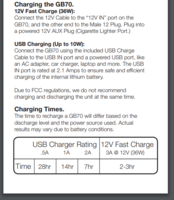Battery Chargers - How I Did It -
So its that time of year again, cold, rainy. . . . . . . flat battery =[
This time we look at Battery Chargers.
Our vans will most likely come with a AGM style starter battery, for this type of battery we need a "Smart Charger" . . . . but what does this mean?
well, chargers of old were of the constant voltage constant current type affair.
They would put out 13.8v at say 5amps and that was it . . . . . . . .
Modern AGM batteries need a much smarter way of being charged properly.
Here’s an extract from OPTIMA:
Here are a couple of things to keep in mind when maintaining your Absorbent Glass Mat (AGM) battery,
Many newer battery chargers, , have microprocessors that collect information from the battery and adjust the current and voltage accordingly. Some have different settings for charging flooded, gel and AGM batteries.
All lead-acid batteries can experience sulfation—the formation of lead sulfate crystals upon discharge. Look for a charger with a desulfation mode to help condition your battery and keep it performing at its best.
Low and slow is best. A low amp charger (one to 12 amps) is generally the best choice for charging any lead-acid battery. It's quicker to charge at higher amperage, but it also can generate a lot of heat, which reduces the life of a battery, just like the heat of summer.
Alternators are NOT chargers. Don't rely on your alternator to do the work of a charger. If your battery is discharged to the point where it cannot start your vehicle, use a charger as soon as possible to make sure your battery gets fully charged.
So we need a decent modern smart charger, ok fine but which one?
well there are a few on the market, here are a notable few manufacturers that stand out.
CTEK - CTEK | Battery chargers for all types of vehicles
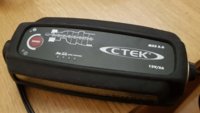
NOCO - NOCO | Start Dead Batteries

VICTRON - Victron Energy

They all sell smart chargers, they can be fitted with quick disconnects or be hard wired, they can also be installed permanently inside the vehicle also,
When permanently installed they will charge the battery when the van is connected to a EHU either onsite or at home, which is nice . . . . . .
some units like one from victron also do multiple outputs so the one charger can charger can charge the starter battery and also the leisure battery bank. . . . . very handy.
the quick disconnects are also worth looking into, also note that even though they all look similar disconnects from different companies do not work with each other. These are great for connecting the M6/M8 eyelets direct to the battery and then with an extension you can safely lock the van with the charger safely connected, these chargers can be left connected like this indefinably.
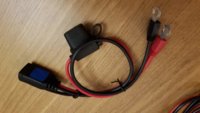
Other connection options are also available. You can get a 12v AUX plug to plug into the socket to indirectly charge the battery, though note 10Amps is normally the max current for that method.

OBD2 port connection is also an option, you can buy “memory savers” which is basically a way of back feeding power to the car/van via the “direct battery connection” of the OBD2 port while you change your main battery (just remember that the battery positive terminal cable will be live when you change they battery so make sure you insulate it!! I normally stuff the cable end into a leather glove so it can’t short out) . . . . . . . this method can be used to charge the battery too. I remember one T6F member stating that the VWCV guy had actually recommended this method as connecting a smart charger . . . . (Suppose it’s a kinda idiot proof solution) though again I would only use a low Amp charger as the OBD2 pin connection would not support the large current chargers.
So what charger do we need?
Smart Automatic Battery Chargers:
The basic stages of charging from flat, using an automatic type charger are:
Bulk Charge - During this process a constant current is supplied to the battery at a rate determined by the battery charger. Most automatic battery chargers will detect the type of battery being charged and apply an appropriate current at a constant rate until the battery is about 70% charged.
Absorption Charge - During this stage the charger maintains a constant voltage to the battery and the charging current tapers off naturally when the battery nears full charge.
Float Charge - When the current flow reaches a pre-determined set point which indicates the end of the absorption charge stage, the charger automatically switches over to float charge. The purpose of this stage is to simply maintain the battery at full charge.
Most modern battery chargers are of the automatic 3 stage type and will detect the type of battery under charge to adjust the above 3 stage charging process accordingly.

What Size Battery Charger:
As a general rule of thumb, when selecting a charger choose an approved battery charger equal to at least 10% of the battery capacity i.e. for a 120Ah battery choose a 15A charger.
The charge current should preferably not exceed 0,2C (20A for a 100Ah battery).The temperature of a battery will increase by more than 10°C if the charge current exceeds 0,2C. Therefore temperature compensation is required if the charge current exceeds 0,2C.
Deep Cycle AGM: - AGM batteries should be charged using a charger with a mode switch for AGM type batteries. It is recommended to use a charger, current limited to 20% or 0.2C of the batteries capacity at a charging voltage of between 14.6 – 14.8V following deep cycle use, or 13.6V – 13.8V for standby use. Charging should be paused if the battery or ambient temperature exceeds 50°C.
Deep Cycle Batteries: - Wet flooded deep cycle batteries should be recharged overnight at a rate equivalent to 10% of the battery capacity. State of charge should be regularly checked using a hydrometer or multimeter to ensure optimum battery condition is achieved.
Deep Cycle Gel: - Century Deep Cycle Gel batteries should be recharged using a charger recommended for Gel type batteries. The charging voltage is lower for Gel batteries and charging should be paused if the battery or ambient temperature exceeds 50°C. Charging using a vehicles alternator is not recommended as the current limit will be too high and can lead to over charging if not regularly checked. Use a charger, current limited to 0.2C (20% of battery capacity) at a charging voltage between 14.1-14.4Volts following cyclic use or 13.5- 13.8V following standby use.
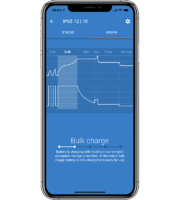
So whats a C-Rate?
Charge and discharge rates of a battery are governed by C-rates. The capacity of a battery is commonly rated at 1C, meaning that a fully charged battery rated at 100Ah should provide 1A for 100 hours. The same battery discharging at 0.5C should provide 500mA for 200 hours, and at 2C it delivers 2A for 50 hours. Losses at fast discharges reduce the discharge time and these losses also affect charge times.
A C-rate of 1C is also known as a one-hour discharge; 0.5C or C/2 is a two-hour discharge and 0.2C or C/5 is a 5-hour discharge. Some high-performance batteries can be charged and discharged above 1C with moderate stress.
Things to note:
Most batterys only have 50% usable energy of the rated Ah, so that 50% of 110Ah is only 55Ah !!
If you needed 100Ah to run your camping kit, you would need 200Ah worth of AGM batterys.
A battery is classified as 100% full at >12.6V, and 50% @ 12.05V and flat <11.99V
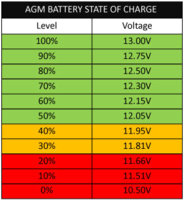
Some data sources:
https://www.centurybatteries.com.au...alk/issue-2-battery-talk-battery-charging.pdf
http://web.mit.edu/evt/summary_battery_specifications.pdf
https://www.victronenergy.com/upload/documents/Datasheet-GEL-and-AGM-Batteries-EN.pdf
Charles-Augustin de Coulomb's C-Rate for Batteries
Video uploaded shortly . . . . . . . . . . .
Battery Chargers - How I Did It -
.
****************************
edit:
my solution . . .
power, neg and quick disconnect for the starter battery . . . .
cover:

normal layout:

battery neg with NO CONNECTIONS:

my own fusebox, with incoming fuse and outgoing fuses. . . . which shows the Victron quick disconnect i use for direct battery charging.

the starter BM2 unit . . . . . didnt even realize that CTEK monitor was still fitted . . . though i binned it off ages ago lol . . . make sure everything is fused correctly

main battery connection . . . ( needs ferals and heat shrink - ill sort that soon )

and my earth link cable to body ground...

thats my solution.
***************************************************************************************
EDIT: 2021 refresh
The 2021 line-up for EHU battery chargers is:
5A CTEK MSX 5.0 - 5A CTEK MSX 5.0
10A NOCO GENIUS10 - NOCO Introducing GENIUS10,
15A Victron IP65 BSC - Victron Energy Blue Smart IP65 Charger
30A Victron IP22 BSC - 30A Victron IP22 BSC
***************************************************************************************
******************************************************
******************************************************
So its that time of year again, cold, rainy. . . . . . . flat battery =[
This time we look at Battery Chargers.
Our vans will most likely come with a AGM style starter battery, for this type of battery we need a "Smart Charger" . . . . but what does this mean?
well, chargers of old were of the constant voltage constant current type affair.
They would put out 13.8v at say 5amps and that was it . . . . . . . .
Modern AGM batteries need a much smarter way of being charged properly.
Here’s an extract from OPTIMA:
Here are a couple of things to keep in mind when maintaining your Absorbent Glass Mat (AGM) battery,
Many newer battery chargers, , have microprocessors that collect information from the battery and adjust the current and voltage accordingly. Some have different settings for charging flooded, gel and AGM batteries.
All lead-acid batteries can experience sulfation—the formation of lead sulfate crystals upon discharge. Look for a charger with a desulfation mode to help condition your battery and keep it performing at its best.
Low and slow is best. A low amp charger (one to 12 amps) is generally the best choice for charging any lead-acid battery. It's quicker to charge at higher amperage, but it also can generate a lot of heat, which reduces the life of a battery, just like the heat of summer.
Alternators are NOT chargers. Don't rely on your alternator to do the work of a charger. If your battery is discharged to the point where it cannot start your vehicle, use a charger as soon as possible to make sure your battery gets fully charged.
So we need a decent modern smart charger, ok fine but which one?
well there are a few on the market, here are a notable few manufacturers that stand out.
CTEK - CTEK | Battery chargers for all types of vehicles

NOCO - NOCO | Start Dead Batteries

VICTRON - Victron Energy

They all sell smart chargers, they can be fitted with quick disconnects or be hard wired, they can also be installed permanently inside the vehicle also,
When permanently installed they will charge the battery when the van is connected to a EHU either onsite or at home, which is nice . . . . . .
some units like one from victron also do multiple outputs so the one charger can charger can charge the starter battery and also the leisure battery bank. . . . . very handy.
the quick disconnects are also worth looking into, also note that even though they all look similar disconnects from different companies do not work with each other. These are great for connecting the M6/M8 eyelets direct to the battery and then with an extension you can safely lock the van with the charger safely connected, these chargers can be left connected like this indefinably.

Other connection options are also available. You can get a 12v AUX plug to plug into the socket to indirectly charge the battery, though note 10Amps is normally the max current for that method.

OBD2 port connection is also an option, you can buy “memory savers” which is basically a way of back feeding power to the car/van via the “direct battery connection” of the OBD2 port while you change your main battery (just remember that the battery positive terminal cable will be live when you change they battery so make sure you insulate it!! I normally stuff the cable end into a leather glove so it can’t short out) . . . . . . . this method can be used to charge the battery too. I remember one T6F member stating that the VWCV guy had actually recommended this method as connecting a smart charger . . . . (Suppose it’s a kinda idiot proof solution) though again I would only use a low Amp charger as the OBD2 pin connection would not support the large current chargers.
So what charger do we need?
Smart Automatic Battery Chargers:
The basic stages of charging from flat, using an automatic type charger are:
Bulk Charge - During this process a constant current is supplied to the battery at a rate determined by the battery charger. Most automatic battery chargers will detect the type of battery being charged and apply an appropriate current at a constant rate until the battery is about 70% charged.
Absorption Charge - During this stage the charger maintains a constant voltage to the battery and the charging current tapers off naturally when the battery nears full charge.
Float Charge - When the current flow reaches a pre-determined set point which indicates the end of the absorption charge stage, the charger automatically switches over to float charge. The purpose of this stage is to simply maintain the battery at full charge.
Most modern battery chargers are of the automatic 3 stage type and will detect the type of battery under charge to adjust the above 3 stage charging process accordingly.

What Size Battery Charger:
As a general rule of thumb, when selecting a charger choose an approved battery charger equal to at least 10% of the battery capacity i.e. for a 120Ah battery choose a 15A charger.
The charge current should preferably not exceed 0,2C (20A for a 100Ah battery).The temperature of a battery will increase by more than 10°C if the charge current exceeds 0,2C. Therefore temperature compensation is required if the charge current exceeds 0,2C.
Deep Cycle AGM: - AGM batteries should be charged using a charger with a mode switch for AGM type batteries. It is recommended to use a charger, current limited to 20% or 0.2C of the batteries capacity at a charging voltage of between 14.6 – 14.8V following deep cycle use, or 13.6V – 13.8V for standby use. Charging should be paused if the battery or ambient temperature exceeds 50°C.
Deep Cycle Batteries: - Wet flooded deep cycle batteries should be recharged overnight at a rate equivalent to 10% of the battery capacity. State of charge should be regularly checked using a hydrometer or multimeter to ensure optimum battery condition is achieved.
Deep Cycle Gel: - Century Deep Cycle Gel batteries should be recharged using a charger recommended for Gel type batteries. The charging voltage is lower for Gel batteries and charging should be paused if the battery or ambient temperature exceeds 50°C. Charging using a vehicles alternator is not recommended as the current limit will be too high and can lead to over charging if not regularly checked. Use a charger, current limited to 0.2C (20% of battery capacity) at a charging voltage between 14.1-14.4Volts following cyclic use or 13.5- 13.8V following standby use.

So whats a C-Rate?
Charge and discharge rates of a battery are governed by C-rates. The capacity of a battery is commonly rated at 1C, meaning that a fully charged battery rated at 100Ah should provide 1A for 100 hours. The same battery discharging at 0.5C should provide 500mA for 200 hours, and at 2C it delivers 2A for 50 hours. Losses at fast discharges reduce the discharge time and these losses also affect charge times.
A C-rate of 1C is also known as a one-hour discharge; 0.5C or C/2 is a two-hour discharge and 0.2C or C/5 is a 5-hour discharge. Some high-performance batteries can be charged and discharged above 1C with moderate stress.
Things to note:
Most batterys only have 50% usable energy of the rated Ah, so that 50% of 110Ah is only 55Ah !!
If you needed 100Ah to run your camping kit, you would need 200Ah worth of AGM batterys.
A battery is classified as 100% full at >12.6V, and 50% @ 12.05V and flat <11.99V

Some data sources:
https://www.centurybatteries.com.au...alk/issue-2-battery-talk-battery-charging.pdf
http://web.mit.edu/evt/summary_battery_specifications.pdf
https://www.victronenergy.com/upload/documents/Datasheet-GEL-and-AGM-Batteries-EN.pdf
Charles-Augustin de Coulomb's C-Rate for Batteries
Video uploaded shortly . . . . . . . . . . .
Battery Chargers - How I Did It -
.
****************************
edit:
my solution . . .
power, neg and quick disconnect for the starter battery . . . .
cover:
normal layout:
battery neg with NO CONNECTIONS:
my own fusebox, with incoming fuse and outgoing fuses. . . . which shows the Victron quick disconnect i use for direct battery charging.
the starter BM2 unit . . . . . didnt even realize that CTEK monitor was still fitted . . . though i binned it off ages ago lol . . . make sure everything is fused correctly
main battery connection . . . ( needs ferals and heat shrink - ill sort that soon )
and my earth link cable to body ground...
thats my solution.
***************************************************************************************
EDIT: 2021 refresh
The 2021 line-up for EHU battery chargers is:
5A CTEK MSX 5.0 - 5A CTEK MSX 5.0
10A NOCO GENIUS10 - NOCO Introducing GENIUS10,
15A Victron IP65 BSC - Victron Energy Blue Smart IP65 Charger
30A Victron IP22 BSC - 30A Victron IP22 BSC
***************************************************************************************
******************************************************
******************************************************
Last edited:


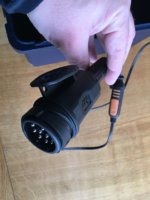
![20200429_112006[1].jpg 20200429_112006[1].jpg](https://www.t6forum.com/data/attachments/67/67687-9ebd6adde6a081672a22895c40a0a180.jpg)
